|
|
 |
|
|
|
Vernadsky's Method
Biophysics And the Life Process
by Wolfgang Lillge, M.D.
(Full text of article from Summer 2001 21st Century)
|
|
|
|
It has been the legacy of Vernadsky to the future world, to continue the broad-based research effort he began, to uncover the physical principles that are behind the differences between living and non-living processes. As we have heard in Jonathan Tennenbaum's contribution (p. 14), Vernadsky himself always emphasized a universal approach to this problem: What is needed is an understanding of what are the physical characteristics of life that can be measured, among others, in terms of different types of radiation, different wavelengths, magneto-biological criteria, the coupling between various living systems, between living and non-living systems, between living systems and astrophysical systems, and also between non-living and astrophysical systems, and so on.
I want to report here about a number of biological technologies that have been developed completely outside of the molecular biology mainstream in the last 30 years, which provide fascinating insights into the inner state of living cells. What has been established by these means is, that cells have a specific kind of communication that is closely connected to extremely weak, but biologically highly effective, electromagnetic signals. By that, a new pathway of biophysical research has been opened, which focusses exactly on those key aspects of life that are systematically ignored by standard methods of molecular biology and genetics.
In fact, the question "What is life?" has been effectively removed from the established thinking in biology. Molecular biology, which focusses exclusively on researching only the "building blocks" of nature, has completely lost sight of the characteristic differences between living and dead matter. For molecular biology, there is no qualitative difference between a living and a dead cell: Just before and after dying, a cell still contains the same molecules and structures.
But what has happened in between? Where is the "living force" or "animus vitae," as was once speculated about?
Before we elaborate more on the nature of those electromagnetic signals, which can also be called "biophotons," we should look at some of the phenomenal achievements of which living processes are capable. In growing tissue, it can be estimated that every single cell produces some million molecules per second, which is more, by several magnitudes, than what can be produced by laboratory means.
There is another astounding figure: On average, every human being consists of approximately 10 trillion cells (1013), which are generated by 43 successive rounds of cell doublings. Only after this impressive precision work, will a human being reach adulthood.
However, at the same time, there is a constant turnover of cells coming and going: In every individual, every second, approximately 10 million cells die, and must be replaced in a short period of time, in order to prevent an entropic decay. It cannot be predicted where and when a cell will die, but if the replacement rate were to be only slightly lower (or higher), the body would disintegrate quickly. For example, if the growth rate of intestinal cells, which have a large turnover themselves, would exceed the cell death rate by only some percent, the body would rapidly die from obstruction of the intestines.
The biophysicist Fritz Popp has pointed to the conditions which must be fulfilled such that all these complex processes occur in a controlled way. There must be an intimate coupling of cell-to-cell-communication, which, according to his calculations, can only be possible when the key control processes occur at the speed of light. Any other means of "information" transmission, including biomolecules, chemical messengers, and so forth, would not be sufficient. They would be too slow to guarantee the integrity of the organism. Already, from this simple calculation, it follows that light, or some electromagnetic action operating at the speed of light, must be involved in some form in the organization of living processes.
The first sytematic research into the role of light in living processes was done by the Russian scientist Alexander Gurwitsch, a contemporary of Vernadsky, in the 1920s. Gurwitsch established as a conclusive hypothesis that every living cell emits light, though at a very weak level.
Mitogenetic Radiation
His original experiment was very simple (Figure 1). Gurwitsch mounted an onion root in such a way, that the tip of this first onion root pointed to the side of another onion root, but without direct contact. When the second onion root, after a certain time, was investigated under the microscope, it was shown that at exactly the point of near-contact, there was a significant increase of cell divisions (mitosis) compared to the opposite side.
|
|
|
|
|
|
|
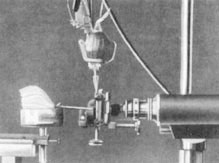 |
|
Figure 1
GURWITSCH'S FAMOUS ONION EXPERIMENT
The roots of two onions are positioned perpendicularly so that the tip of one root points to one side of the other root. Gurwitsch found that there was a significant increase in cell divisions on this side, compared to the opposite, "unirradiated" side. The effect disappeared when a thin piece of window glass was placed between the two roots, and reappeared when the ordinary glass (which is opaque for ultraviolet light) was replaced with quartz glass, which is transparent for ultraviolet light.
Source: A.G. Gurwitsch, Das Problem der Zellteilung (The Problem of Cell Division), 1926.
|
|
|
|
|
Alexander Gavrilovich Gurwitsch (1874-1954)
|
|
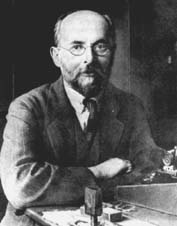 This "mitogenetic effect," as Gurwitsch termed it, continued to appear when a small quartz window, which is specifically transparent to ultraviolet light, was inserted between the two onion roots. However, the effect disappeared when the quartz window was replaced by normal window glass, or other material, which is opaque to ultraviolet light. With several other experiments Gurwitsch was able to definitely prove that the medium of this mitogenetic effect was, in fact, a very weak ultraviolet radiation emanating from the tip of the first onion root. He called this "mitogenetic radiation." This "mitogenetic effect," as Gurwitsch termed it, continued to appear when a small quartz window, which is specifically transparent to ultraviolet light, was inserted between the two onion roots. However, the effect disappeared when the quartz window was replaced by normal window glass, or other material, which is opaque to ultraviolet light. With several other experiments Gurwitsch was able to definitely prove that the medium of this mitogenetic effect was, in fact, a very weak ultraviolet radiation emanating from the tip of the first onion root. He called this "mitogenetic radiation."
Subsequently, Gurwitsch and his collaborators developed a method to indirectly measure the intensity and spectral distribution of the "mitogenetic radiation." This technique, together with Gurwitsch's other original contributions to biology, including his notion of the biological field and the existence of a long-range effect between cells during mitosis, became one of the main fields of biological research during the 1930s, in the Soviet Union, and elsewhere.
However, increasingly, this approach to biology came under fierce attack by the proponents of genetics and molecular biology, which then, after the war, was made the dominant field of research. The major point of criticism from these circles was, that the mitogenetic radiation did not exist at all, or, if it did exist, it had no biological relevance whatsoever.
Actually, at Gurwitsch's time, it was technically impossible to directly measure the weak light emission from cells. This became possible only in the 1950s, when a group of Italian astronomers developed a very sensitive photo multiplier, which they used to make distant stars visible. When used on biological samples, it was shown that leaves, germs of wheat, corn, beans, and so on, emit a constant, but weak light. These results created a brief uproar in the West, but the affair was then essentially forgotten.
Only in the early 1970s was this basic insight taken up again, when German biophysicist Fritz Popp, in his work on cancer research, found some very peculiar properties of a very strong carcinogenic substance.
Shown in Figure 2 is benzpyrene in two forms: the 3,4 benzpyrene, which is found in coal-tar and in cigarette smoke, and a chemically very similar substance, 1,2 benzpyrene, which is considered harmless. The only major difference between the two substances is that 3,4 benzpyrene has a strong absorption/emission anomaly in the ultraviolet area of the spectrum. Popp asked himself, could these optical properties of the molecule be the direct cause of its carcinogenicity, rather than any assumed chemical (molecular) effect? That idea, of course, went directly against the established position of cancer research.
|
|
|
|
|
|
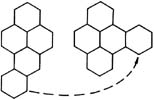
|
3,4 benzpyrene
|
|
1,2 benzpyrene |
|
|
Figure 2
TWO FORMS OF BENZPYRENE
The 3,4 benzpyrene, which is found in coal-tar and in cigarette smoke, is chemically very similar to 1,2 benzpyrene, which is considered harmless. The only major difference between them is that 3,4 benzpyrene has a strong absorption/emission anomaly in the ultraviolet area of the spectrum. Popp asked himself, could these optical properties of the molecule be the direct cause of its carcinogenicity?
|
|
|
|
|
|
|
Figure 3
SCHEMATIC OF POPP'S PHOTOMULTIPLIER
Popp and his colleagues built a high-sensitivity light amplifier, shown here schematically, which can reliably measure the extremely weak light emission of biological experiments. A quartz cuvette is located in the enclosed part of the apparatus before a concave mirror, which also directs the reflected rays to the light detector. A colored filter can select specific wavelengths, and the alternating light and dark ("chopper") plate allows a separation betwen actual signals from the probe and spurious light from the apparatus itself.
Source: Popp, Biologie des Lichts, 1984
|
|
|
|
|
|
|
In that context, Popp learned about Gurwitsch's work on mitogenetic radiation, and concluded that, if the assumed optical effect of benzpyrene were correct, then there must be some kind of light source in the cell, and very weak photon "signals" would be able to trigger drastic changes in the behavior of cells.
So, Popp and his collaborators started to construct a very sensitive light amplifier appropriate for measuring very weak photon emissions from cells. A schematic view of this machine is shown in Figure 3.
It is a certain irony that Popp, after he had presented his ideas to leading cancer scientists in Germany, was first denied any research money, because he said he wanted to find light inside cells. For these people, this was a completely absurd idea! Only when he pledged to establish that there is no light in cells, did he receive some funding.
With Popp's photomultiplier machine, it was possible to prove beyond any doubt that low-level light emissions are a common property of all living cells. It has different intensities for plant or animal cells, for different cell types, and it can vary from one moment to the next. It is not regular, but comes often as "photon explosion" (spikes), especially when the cells are irritated by outside means.
With Popp's photomultiplier machine, it was possible to prove beyond any doubt that low-level light emissions are a common property of all living cells. It has different intensities for plant or animal cells, for different cell types, and it can vary from one moment to the next. It is not regular, but comes often as "photon explosion" (spikes), especially when the cells are irritated by outside means.
|
|
|
|
|
|
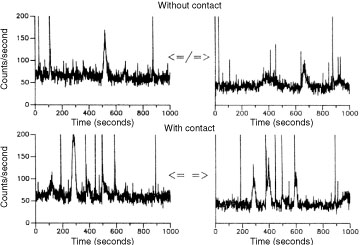 |
|
|
Figure 4
EMISSION PATTERNS OF TWO BIOLOGICAL SAMPLES, WITH AND WITHOUT CONTACT
Fritz Popp developed a system with two independent photo multipliers, and a mechanism by which the two samples under investigation could be optically separated from each other. Here, in an experiment with the tiny dinoflagellate gonyaulax polyedra, the top part of the graph shows the pattern of emissions with the shutter closed; and the bottom graph shows the experiment with the shutter opened, so that the two samples are in optical contact. As can be seen, the random events on the top, become a coordinated, tuned process of increased intensity, with simultaneous spikes of photon emissions.
|
|
|
Listen to the harmony of biophotons
|
|
The tones correspond to the correlation of signals of photon emission in two samples of gonyaulax polyedra. In the first part of the audio, the dissonance of the separated samples is heard; in the second part, the harmony of the two samples in optical contact can be heard. The higher the tone, the better the correlation of signals in the two samples. |
|
|
|
|
The Harmony of Biophotons
In fact, one could draw an analogy to music and say, that a disharmonic process turns harmonic. Actually, as Johannes Kepler perceived the relations of the planets as a musical harmony of spheres, we can also, in the case of biophotons, make this harmony audible. Here is how Fritz Popp set the electromagnetic communication between cells to music! Please, don't expect these tones to be as beautiful as those in last night's concert, but creatures such as these dinoflagellates are not human, after all! First, we hear the dissonance of the separated samples, and then the harmony of interacting photon emission. [Audio version of the biophoton tones.] You should note that the tones you will hear do not correspond directly to single photons emitted; they correspond to the degree of correlation of signals in both samples. So, the higher the tone, the better the correlation.
All these findings point to a specific form of electromagnetic coupling, indicating a specific kind of communication between living cells. Even if it is not yet known what the actual source of these photon emissions in cells is—and one should not fall into premature speculation on this point (there may even be outside, astrophysical influences involved)—they have a definite biological effectiveness. And Popp has also shown that this weak radiation must have the quality of a multimodal, multifrequency laser to be effective; that is, to be coherent in space and time.
Coming back to cancer research, it is not surprising that the use of photon emission is able to show a clear distinction between healthy cells and cancer cells.
The graph in Figure 5 shows how normal liver cells (lower curve) have a relatively stable or even falling level of photon counts at increasing cell density, while cancer cells of the same cell type show an increasing photon count at higher cell densities. It can be concluded from that, that populations of cancer cells have lost the harmony and coherence that is typical for healthy tissue.
|
|
|
|
|
|
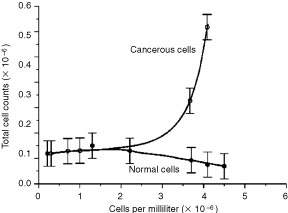 Figure 5 Figure 5
PHOTON COUNTS OF NORMAL LIVER CELLS VS. CANCEROUS CELLS
Normal liver cells (lower curve) have a relatively stable or even falling level of photon counts at increasing cell density, while cancer cells of the same cell type show an increasing photon count at higher cell densities. From this, it was concluded that populations of cancer cells have lost the harmony and coherence that is typical for healthy tissue.
|
|
|
|
|
|
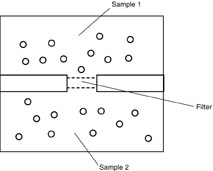 |
|
Figure 6
SCHEMATIC OF BURLAKOV'S EXPERIMENTS WITH FISH EGGS AND MITOGENETIC RADIATION
In these experiments, samples of fertilized fish eggs in different phases of development were brought into optical contact with each other. Burlakov found that if the age difference between the eggs or larvae was not too large, there was a significant acceleration in the development of the younger eggs relative to the older ones. However, if the age difference was large, the younger eggs showed a strong retardation in development; even deformities and higher death rates occurred. When Burlakov used normal window glass as a filter, all these effects disappeared, but with quartz filters, the effects could be observed.
|
|
|
|
|
|
|
I can only summarily report here on recent, impressive work by the Russian scientist A.B. Burlakov. He provided a striking example of the superiority of the biophoton approach over the molecular dogma.
Burlakov brought samples of fertilized fish eggs in different phases of development into optical contact with each other, and observed the mutual effects (see Figure 6). He reported the following results:
- Provided the age difference between the eggs or larvae was not too large, there was a significant acceleration in the development of the younger eggs relative to the older ones.
- However, if the age difference was large, the younger eggs showed a strong retardation in development; even deformities and higher death rates occurred. (This conforms, by the way, to observations in nature, that fish normally avoid laying their eggs in sites where other eggs have already been deposited.)
- When he used normal window glass as a filter, all these effects disappeared, but the effects could be observed by use of quartz filters, confirming clearly Gurwitsch's "mitogenetic effect."
- Using filters for different wavelengths and polarizers, Burlakov even succeeded in creating specific alterations intentionally, and subsequently undoing them. In this way, monster larvae with multiple heads, multiple hearts, and so forth, were generated, but could be corrected by the appropriate use of other optical coupling effects.
In fact, this latter case could be the beginning of an era of "biophoton technology," as Burlakov himself stated, with a potential far bigger than today's biotechnology, which has had a hard time keeping up with its far-flung promises. Obviously, in Burlakov's experiments, no changes were induced in the genome at all—the biophoton action works on the level of the living process itself.
Magneto-Biology
Finally, we should include in the list of technologies for the investigation of living processes, the potential of magneto-biology. Research of this type has a long tradition, especially in Russia. For example Alexander L. Chizhevsky [1897-1964] made intensive studies of the correlation between solar-induced changes in the Earth's magnetic field and the occurrence of physical events, such as epidemics, and other things. Also Simon Shnoll and his group in Moscow made extensive studies of the influence of cosmic phenomena on almost all physical processes on the planet. Professor Bruno Brandimarte of Italy has been a pioneer in the field of magneto-biology for many years. He has shown that oscillating magnetic fields of various forms can have striking effects on the healing of wounds and the increase of blood circulation.
In Figure 7, you see on the left a very bad case of diabetes gangrene, which would have been hopeless for traditional surgery. But, after treatment with magnetic fields (right), the foot was almost completely restored.
|
|
|
|
|
|
 |
|
|
Figure 7
BRANDIMARTE'S OSCILLATING MAGNETIC FIELD TREATMENT
The Italian scientist Brandimarte has worked with oscillating magnetic fields to increase blood circulation and heal wounds. Here is one example of the positive effect of magnetic field treatment. On the left is a very bad case of diabetes gangrene for which the normal treatment would have been amputation. After treatment with magnetic fields (right), however, the foot was almost completely restored.
|
|
|
|
|
|
In conclusion, it must be stated, that we are only at the beginning of the era of "life technology." Many more approaches like the mitogenetic effect, the biophoton/laser principle, and magneto-biology must be developed. The aim is to develop methods, which allow us to study all those multiple levels, on which the characteristic actions of life occur.
Wolfgang Lillge, a physician, is the editor of the German-language Fusion magazine.
This article was part of a panel discussion on Vernadsky’s Method, at the Schiller Institute conference, The Ecumenical Battle for the Common Good, held in Bad Schwalbach, Germany, May 4-6, 2001. The four panel presentations appear in full in the Summer 2001 issue of 21st Century.
|
| Return to top |
|
|
|
|
|
|
|